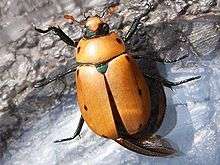Grapevine beetle
| Grapevine beetle | |
|---|---|
 | |
| Scientific classification | |
| Kingdom: | Animalia |
| Phylum: | Arthropoda |
| Class: | Insecta |
| Order: | Coleoptera |
| Family: | Scarabaeidae |
| Genus: | Pelidnota |
| Species: | P. punctata |
| Binomial name | |
| Pelidnota punctata (Linnaeus, 1758) | |
| Wikispecies has information related to: Pelidnota punctata |
The grapevine beetle, Pelidnota punctata, also known as the spotted June beetle or the spotted pelidnota, is a species of beetle, a member of the subfamily Rutelinae of the Scarab beetle family. Grapevine beetles are common in the north and central United States and Eastern Canada, but do relatively little damage to their host plants. The beetles fly at a fast speed, usually in a curving flight.
The adult beetle is approximately 2.5 centimetres (1 inch) long, but can reach 3 cm (1.2 in) occasionally. Its pattern is off-yellow or auburn red, with three black spots running down each side. Fine black lines divide the edges of its elytra. There are two different variations of Pelidnota punctata, the southern variation lacks the darker legs, while the northern variation has darker legs. As Philip Harpootlian points out, the grapevine beetle is a variable species — so much so that T.L. Casey named ten species and subspecies in 1915, names that were later merged back into Pelidnota punctata.[1]
Its color, shape, spots, and behavior sometimes lead it to be misidentified as a giant ladybug. While both are beetles, they are from different families.
Habitat and diet
The beetle lives in the eastern coast of North America, as well as Florida, Nebraska and north western Missouri, and has been found in central Indiana, South Dakota, Minnesota, southern Wisconsin, southeast Michigan, and southwestern Ontario. Also just found in northwestern Kentucky, southwestern Ohio, Illinois, Maryland, New York, South Western Connecticut, western and eastern Pennsylvania, Northern Michigan, eastern West Virginia, Northern Iowa and North Carolina. It lives, like many beetles, in forests, thickets, and woods, and is mostly seen during the summer. Active flyers, these beetles are commonly attracted to lights at night. It is also seen in vineyards and gardens.
The adult beetle eats the leaves and fruit of grapevines, both wild and cultivated, although it is not normally a major pest of vineyards.
Beetle eggs are laid in rotten wood, tree stumps, or on soil near the host plant, where they hatch into larvae. Larvae then dig their way into the soil, where they feed on rotted wood. Pupal chambers are built shallowly underground. The adults emerge in July.[2]
References
- ↑ http://www.insectsofwestvirginia.net/b/pelidnota-punctata.html
- ↑ Milne, Lorus, and Margery Milne. 2000. National Audubon Society Field Guide to North American Insects and Spiders. New York: Knopf. 989 pp. ISBN 0-394-50763-0.